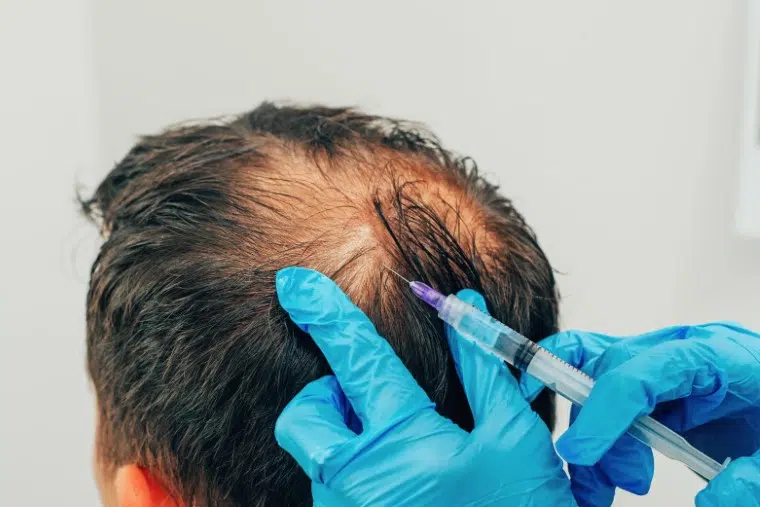How long does PRP hair treatment last?
Hair loss is a common concern affecting millions of people worldwide, leading many to seek effective and long-lasting solutions. Among the various treatments available, PRP hair treatment has gained significant popularity due to its natural approach and promising results. If you're considering PRP hair treatment in Dubai one of the most important questions you may have is: How long do the results last? This article explores the duration of PRP therapy for hair restoration, the factors influencing its longevity, and what you can expect from the procedure.
What is PRP Hair Treatment?
PRP (Platelet-Rich Plasma) therapy is a non-surgical treatment that uses the patient’s own blood to stimulate hair growth. The process involves drawing a small amount of blood, processing it to concentrate the platelets, and injecting the plasma into the scalp. Platelets contain growth factors that promote tissue repair and regeneration, making them effective in revitalizing dormant hair follicles.Unlike medications or topical solutions, PRP harnesses the body’s natural healing mechanisms, reducing the risk of adverse reactions. However, since results vary from person to person, understanding the longevity of the treatment is crucial before committing to the procedure.
How Long Do PRP Hair Treatment Results Last?
The duration of PRP hair treatment results depends on several factors, including the patient’s hair loss condition, overall health, and adherence to maintenance sessions. On average, patients can expect the effects to last between 12 to 18 months.

Initial Results and Timeline
After the first session, patients typically notice reduced hair shedding within 4 to 6 weeks. Visible hair thickening and new growth may take 3 to 6 months, with optimal results appearing after a full course of treatments (usually 3 to 4 sessions spaced 4–6 weeks apart).Since PRP stimulates natural hair growth, the results are progressive rather than instant. Once the desired outcome is achieved, maintenance sessions are recommended to prolong the benefits.
Factors Affecting the Longevity of PRP Treatment
Several variables influence how long PRP hair treatment lasts:
Severity of Hair Loss
Patients with early-stage hair thinning (androgenetic alopecia or mild shedding) tend to experience longer-lasting results compared to those with advanced hair loss. PRP is most effective when hair follicles are still active but weakened.
Individual Healing Response
Since PRP relies on the body’s natural healing process, individuals with faster cell regeneration may see prolonged benefits. Age, genetics, and overall health play a role in how well the scalp responds to treatment.
Lifestyle and Diet
A balanced diet rich in vitamins (especially Biotin, Vitamin D, and Iron) supports hair health and may extend PRP results. Smoking, excessive alcohol consumption, and high stress levels can negatively impact hair growth, shortening the treatment’s effectiveness.
. Maintenance Sessions
While PRP provides lasting results, they are not permanent. Most dermatologists recommend a maintenance session every 6 to 12 months to sustain hair density and prevent further thinning. Skipping these sessions may lead to gradual hair loss recurrence.
Comparing PRP with Other Hair Restoration Methods
PRP is often compared to other hair loss treatments like minoxidil, finasteride, and hair transplants. Here’s how it stands out in terms of longevity:
- Minoxidil & Finasteride: These require continuous use; stopping them reverses results. PRP offers longer-lasting effects without daily medication.
- Hair Transplants: While surgical transplants provide permanent results, they are invasive and costly. PRP is a non-surgical alternative that enhances natural hair growth without scarring.
PRP can also be combined with other treatments for enhanced efficacy, but its standalone results are impressive for those seeking a minimally invasive solution.
What to Expect After PRP Treatment
Post-treatment care influences how long the results last. Patients should:
- Avoid washing hair for 24–48 hours after the procedure.
- Refrain from strenuous exercise or sun exposure for at least 2 days.
- Use gentle, sulfate-free shampoos to maintain scalp health.
Mild redness or tenderness at the injection site is normal but subsides quickly. Following the dermatologist’s aftercare instructions ensures optimal healing and prolonged benefits.
Is PRP Hair Treatment Worth It?
For individuals seeking a natural, non-surgical solution with long-lasting results, PRP is a viable option. While it requires an initial investment and maintenance sessions, many find it preferable to daily medications or invasive surgeries.
Who Is an Ideal Candidate?
PRP works best for:
- Those with mild to moderate hair thinning.
- Individuals with stable health and no blood disorders.
- People willing to commit to multiple sessions for the best outcome.
Patients with complete baldness or inactive hair follicles may not benefit as much and should consult a specialist for alternative options.
Final Thoughts
PRP hair treatment offers a sustainable solution for hair loss, with results lasting up to 18 months when properly maintained. Factors like the extent of hair loss, individual response, and follow-up sessions determine its longevity.If you’re exploring PRP hair treatment consulting a qualified specialist will help assess your suitability and create a personalized plan for lasting results. By understanding the procedure’s timeline and maintenance requirements, you can make an informed decision toward healthier, fuller hair.
